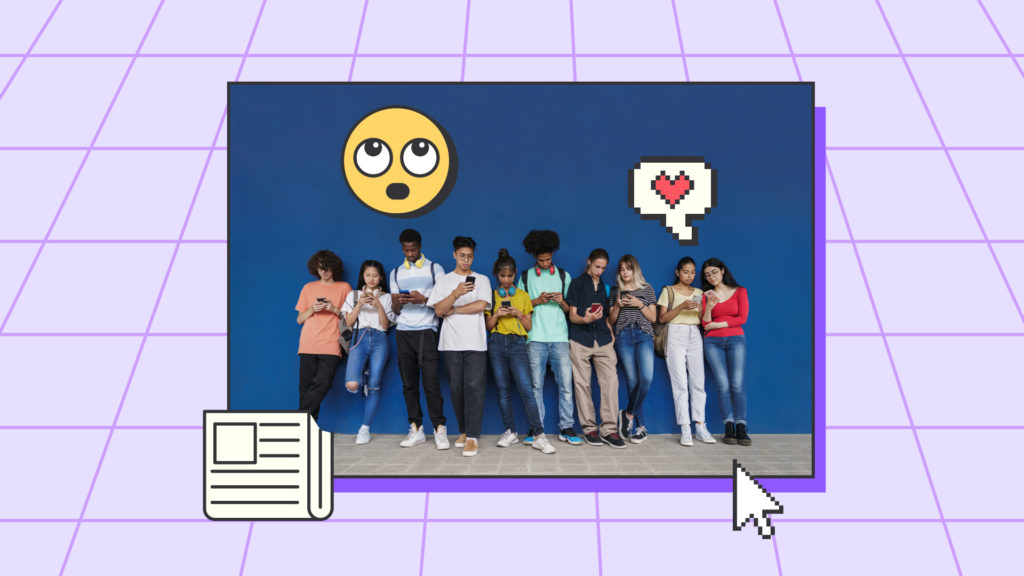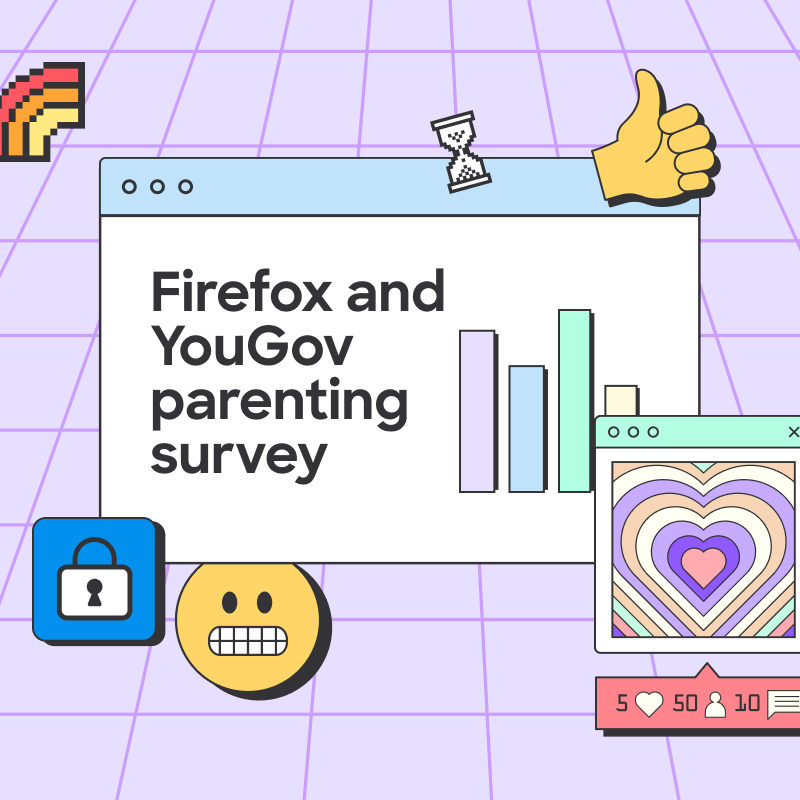A little less misinformation, a little more action

As each generation comes of age, they challenge the norms that came before them. If you were to ask most people their go-to way to search, they would mention a search engine. But for Gen Z, TikTok has become one of the most popular ways to find information.
Adrienne Sheares, a social media strategist and a millennial who grew up relying on search engines, had difficulty grasping the habit. So, she spoke with a small group of Gen Zers and reported what she heard in a recent Twitter thread.
Among her learnings: Young people are drawn to content TikTok curates for them, they prefer watching quick videos over reading, and they know misinformation exists and “will avoid content on the platform that can easily be false.” Sheares’ thread went viral. Her curiosity resonated, especially for people with habits very different to those of Gen Z’s.
As part of our mission at Mozilla, we’re working to support families in having a healthy relationship with the internet. That includes an online experience where young people are equipped to cut through the noise – including misinformation. So we wanted to learn more about how Gen Z consumes the news, and how families can encourage curiosity about current events without shutting out social media. After all, while it may be rife with misinformation, it’s still an essential platform for many teens to connect with their peers.
We spoke with members of Teens for Press Freedom, a youth-led organization that advocates for news literacy among teenagers. We asked Sofia, Agatha, Charlotte, Eloise and Kevin – who are all in their teens – about how they engage with information on social media, their concerns about algorithms and how we can help Gen Zers fight misinformation. Here’s what they said.

Talk to your kids about online safety
Get tipsGen Zers are vocal about their values
The way we consume news has become intrinsically social. People start sharing the news they’re consuming because that’s what you do on Instagram and other platforms. People say, “Hey, I’m reading this and therefore, I fit into this educated part of political American life. I have a real opinion that’s very valid.” Everyone wants to feel like they’re part of that group.
CHARLOTTE, CO-FOUNDER OF TEENS FOR PRESS FREEDOM
Agatha, co-director of Teens for Press Freedom, first took notice of how news spreads on Instagram in 2020, when she was 14.
“There was this post about Palestine and Israel that was incredibly antisemitic,” Agatha recalled. “It was sort of convincing people that they should be antisemitic. That obviously isn’t right. I’m Jewish, and I felt like the post associated Jewish people with the actions of Israel’s government. That felt like misinformation because I didn’t do anything. It seemed to blame people who have never even lived in Israel.”
She started seeing more and more posts with misinformation about other issues, including COVID-19, the Black Lives Matter protests and violence against Asian Americans. “People were sharing them because it looked cool, like they were doing the right thing by spreading these infographics and letting their thousands of followers know about these incidents,” Agatha said.
Many young people want to publicly express their values. However, they run into a problem in the way they do it.
“People weren’t making sure that the information they were spreading was actually correct and not just something somebody had written, copied into a graphic and sent it out to the world,” Agatha said.
Charlotte, who co-founded Teens for Press Freedom and is now an incoming freshman at Dartmouth College, said many people fall into a trap of “virtue signaling.”
“The way we consume news has become intrinsically social,” Charlotte said. “People start sharing the news they’re consuming because that’s what you do on Instagram and other platforms. People say, ‘Hey, I’m reading this and therefore, I fit into this educated part of political American life. I have a real opinion that’s very valid.’ Everyone wants to feel like they’re part of that group.”
The infinite feed has shaped Gen Z’s online habits
There’s something about the endless scroll that is so compelling to people.
CHARLOTTE, CO-FOUNDER OF TEENS FOR PRESS FREEDOM
Facebook launched in 2004, YouTube in 2005, Twitter in 2006, Instagram in 2010 and Snapchat in 2011. Millennials came of age as those platforms exploded. Gen Zers – those born after 1996, or people 25 and younger, as classified by the Pew Research Center – don’t remember a time when the internet wasn’t a major means of personal communication and media consumption.
Social media feeds favor information presented succinctly, so users can quickly move on to the next post one after another. TikTok, launched in 2016, has “hacked that algorithm so well,” Charlotte said. “Now, everyone’s using it. There’s YouTube Shorts, Instagram Reels, Netflix Fast Laughs. There’s something about the endless scroll that is so compelling to people. That just invites us to spend hours and hours learning about the world in that way.”
Teens today have lived most of their lives in that world, and it has affected how they consume the news.
Short attention spans fuel misinformation
When I’m listening to music, I can’t get myself to sit through a full song without skipping to the next one. Consuming things is just what we’re programmed to do.
ELOISE, ADVOCACY DIRECTOR OF TEENS FOR PRESS FREEDOM
Many teens know how to confirm facts through resources on the internet. That’s thanks to ongoing efforts by educators who include verifying information in their lesson plans.
Kevin, workshop team director at Teens for Press Freedom, recently saw a post on Instagram purportedly about a California bill that would allow late-term abortions. “I looked it up because I was curious,” he said. He quickly learned that the law doesn’t actually propose that.
The issue, Kevin said, is taking the time to fact-check.
“We’re a generation constantly fed and fed and fed and given things to consume,” said Eloise, advocacy director at Teens for Press Freedom. “Our attention spans are significantly lower than generations before us. When I’m listening to music, I can’t get myself to sit through a full song without skipping to the next one. Consuming things is just what we’re programmed to do.”
That may be why many Gen Zers prefer watching short videos to learn information instead of reading articles.
“People feel like reading the news is not something to prioritize when they can just look at headlines,” Agatha said. “A lot of newspapers have an audio link now so people listen to it instead. Or it’ll say five-minute read, and people will take five minutes to read it. But they don’t want to spend 10, 20 minutes informing themselves on what’s happening to the world.”
News events become more engaging on social media with flashy imagery and content that highlights the outrageous. While this means platforms have become a breeding ground for misinformation, there’s also a silver lining: Younger generations have become more motivated than ever to engage in issues they care about.
Teens are aware about the power of algorithms
We find that [algorithms are] kind of abusing our personal information.
KEVIN, WORKSHOP TEAM DIRECTOR OF TEENS FOR PRESS FREEDOM
While many Gen Zers feel equipped to figure out what’s real or not on social media, algorithms that feed users content curated to each individual are hurting their ability to slow down and choose what they consume.
“A lot of misinformation are half-truths, like it’s almost believable enough that you can accept it without doing any extra research,” said Sofia, a high school junior and co-director of Teens for Press Freedom. “You go to TikTok to be entertained, and if that entertainment is inundated with misleading information, you’re consuming it without knowing you’re consuming it.”
The teens expressed concern about algorithm-based technologies being tested on young people. Kevin sees it as “abusing their personal information.” Being fed posts based on each person’s interests can create a distorted ecosystem of content that includes misleading, even manipulative, information.
“You’re sucked into this world of people you don’t know, and you see all these different ideas and things that are your interests, and you spend hours and hours on there,” Agatha said. “Their ideas sort of become yours. Your opinion then becomes TikTok’s opinion and vice versa.”
Sofia said this has contributed to the loss of productive conversation around politics: “Algorithms are not only creepy. It’s really damaging not just to the individual but to the political situation in the United States. People are only seeing content that aligns with their beliefs.”
Charlotte said, “There’s this rhetoric about how Gen Z is the most informed generation because of social media, and in many ways that’s true. But social media isn’t really the great democratizer. There’s [also] a lot we don’t know because of these algorithms.”
There are ways to help younger generations fight misinformation
Rather than being talked at, [teens] can talk to each other about issues.
SOFIA, CO-DIRECTOR OF TEENS FOR PRESS FREEDOM
While education about trustworthy sources needs to continue through school, the group said we need to expand the conversation to social media.
“A lot of people our age think that being critical of sources is something school-related,” Kevin said. “People will say something like, ‘I saw this on TikTok, and then you know, very non-reluctantly quote social media as a source of information.”
Applying the process of verifying information on social media means facilitating discussions among people who consume content in similar ways.
“Rather than being talked at, they can talk to each other about issues,” Sofia said. “If they’re convinced by someone their own age that what they’re experiencing is not something that they alone have to go through, or that they alone have to figure out a solution, that makes the whole thing a lot easier to confront.”
For parents, this can mean finding peer-to-peer resources for their kids like Teens for Press Freedom’s misinformation workshops. Families can also have real conversations with their children about their values and issues they care about, encouraging curiosity instead of avoiding complicated topics.
Ultimately, adults can use their power to support efforts to make the internet a better place – one where technology doesn’t use children’s data against them. Young people will tell us what they need if we ask. We can’t let algorithms do that work for us.
The internet is a great place for families. It gives us new opportunities to discover the world, connect with others and just generally make our lives easier and more colorful. But it also comes with new challenges and complications for the people raising the next generations. Mozilla wants to help families make the best online decisions, whatever that looks like, with our latest series, The Tech Talk.


